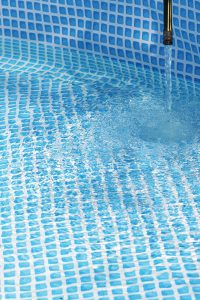When a customer brings in a water sample complaining about an algae problem, pool and spa professionals must ask themselves which chemical parameters to include in the subsequent test. If their answer does not include testing for nitrate nitrogen, they could be ignoring a key factor. In fact, nitrate nitrogen testing should be considered in every situation with a potential algae problem.
High nitrate levels can present a number of water quality problems; before these can be fully addressed, one must understand what nitrates are, how they get into the water and impact water quality, and what to do to control them.
What are nitrates?

If the family dog swims in the pool regularly, nitrate levels can grow significantly.
Nitrate is a nitrogen compound that forms naturally in the soil and atmosphere. These compounds can also be present in swimming pool (or occasionally spa) water, although many times pool and spa professionals are not aware of their presence. Nonetheless, they are all but inevitable and must be addressed.
A nitrate comprises a single nitrogen atom connected to three oxygen atoms (NO3). Nitrates form under the right conditions when nitrogen is introduced into the water. Typically, the nitrogen first forms nitrite (NO2), which quickly steals another oxygen atom from somewhere else to form nitrates. These additional oxygen atoms often come from hypochlorous acid (HOCl), the ‘killing’ form of chlorine, which leads to an increase in overall chlorine demand. Nitrates are also extremely stable, making it easier for them to stay alive in the pool environment.
Where do nitrates come from?
Nitrates are often present right from the water source. As a result, nitrate problems have the potential to start as soon as the pool is filled. The U.S. Environmental Protection Agency (EPA) has established National Primary Drinking Water Regulations (NPDWRs) that allow nitrate nitrogen levels to be as high as 10 parts per million (ppm) and nitrites as high as 1 ppm in municipal drinking water. Fortunately, these nitrate nitrogen levels are not enough to cause significant problems; however, when combined with other sources of nitrogen, problems are likely to occur.
Fertilizer is one of the more common nitrogen sources; even small amounts can make a large difference in the pool environment. While nitrogen is a key nutrient that keeps lawns and plants plush and green, it is not ideal for swimming pools. This issue is of particular importance for homes adjacent to golf courses or other vast green spaces. Consider the amount of fertilizer required for turf upkeep; there is a high likelihood it will make it into nearby backyard pools. This also holds true for neighbours who use a professional lawn service. On a windy day, sprayed fertilizer can drift right into neighbouring backyards.
Other sources of nitrate nitrogen include human and animal waste, rain and leaves or other decaying plant life. If, for example, a dog or resident ducks regularly swim in the pool, or material from a nearby tree tends to drop in the water, nitrate levels can grow significantly.
What do nitrates do to pool water?
Nitrates force sanitizers to do a lot more work, causing residuals to be more quickly depleted. As a result, more sanitizer will be needed and added time and money will be spent balancing pool chemistry levels. Even a small amount of nitrate, perhaps as little 10 ppm, can affect sanitizer demand. Higher amounts will wreak havoc on sanitizer levels; at 50 ppm, nitrates can more than double demand. The situation will become worse as nitrates accumulate.

Algae can become uncontrollable in the presence of a high nitrate supply, quickly making a mess of a pool.
Additionally, algae can become uncontrollable in the presence of a high nitrate supply, quickly making a mess of a pool. In fact, nitrates actually help algae grow, just as they do with plants and grasses in fertilizer form.
If nitrate levels fall below 10 ppm, algae should be controllable using regular methods. Above 10 ppm, routine algaecide additions may be needed to prevent an algae bloom and deal with added sanitizer demand. When nitrate levels rise above 30 ppm, algae can start to get out of control. Ideal free chlorine levels may even be ineffective in preventing algae when nitrate levels are this high.
The nitrate level also tends to be a big problem in the spring, when pools that have been closed all winter and opened for the first time. Any leaves, rain, organic debris or other material that have collected in the pool will likely have significantly increased nitrate nitrogen levels. It is always a good idea to test the nitrate level with the first test of every season, when the water level is already low and a partial drain and refill is less likely to interfere with weekend plans and pool parties.
How are these problems treated?

In most cases, a partial drain and refill will help lower nitrates once they have exceeded ideal levels.
Knowing there is a nitrate issue is the first step in the battle. As such, levels should be tested any time an algae outbreak or increase in chlorine demand occurs. Test strips and test kits are available to perform this task and can easily become part of a regular troubleshooting maintenance routine.
Once identified, try to understand where the nitrates are coming from and prevent them from getting into the pool water. Prevention is the best approach, as treatment is difficult once nitrates are present.
The only practical way to lower nitrates once they have exceeded ideal levels is to drain and refill the pool with water that contains no or very low nitrate levels (ideally less than 1 ppm). In most cases, this can be accomplished with a partial drain and refill. Target nitrate levels should not exceed 10 ppm.
Proceed with caution
Any water sample troubled with algae or high chlorine demand should be tested for nitrate levels to better understand the best control and treatment options. By overlooking nitrates, pool professionals can cost customers extra money and put their own reputations on the line. By letting clients know when a nitrate issue is present, they will be prepared for the extra chlorine and possible algae issues that might arise, even when normal parameters appear to be balanced. Nitrate testing can be the difference in being renowned as an expert or as the company that used to be trusted for swimming pool maintenance advice.
This article was written by Joe Sweazy and originally appeared on Pool & Spa Marketing [link].
